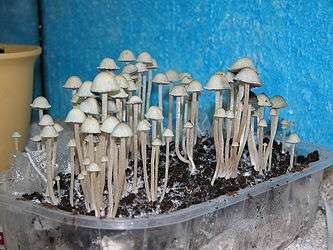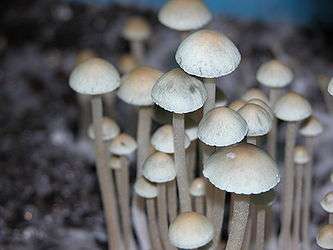Panaeolus cyanescens
Panaeolus cyanescens, also known as Copelandia cyanescens, is a mushroom in the Bolbitiaceae family. Panaeolus cyanescens is a potent psilocybin mushroom and is similar to Panaeolus tropicalis.
| Panaeolus cyanescens | |
|---|---|
 | |
| Panaeolus cyanescens | |
| Scientific classification | |
| Kingdom: | |
| Division: | |
| Class: | |
| Order: | |
| Family: | |
| Genus: | |
| Species: | P. cyanescens |
| Binomial name | |
| Panaeolus cyanescens | |
 | |
| Range of Panaeolus cyanescens | |
| Synonyms | |
|
Agaricus cyanescens | |
| Panaeolus cyanescens | |
|---|---|
float | |
| gills on hymenium | |
| cap is convex | |
| hymenium is adnate | |
| stipe is bare | |
| spore print is black | |
| ecology is saprotrophic | |
| edibility: psychoactive | |
Description
- Cap: 1.5 – 4 cm across, dry, at first hemispheric, expanding to campanulate to convex, with an incurved margin when young. Young caps start out light brown and fade to off-white or light gray at maturity, sometimes with yellowish or brownish tones. Often developing cracks in dry weather, slightly hygrophanous, turning greenish or blue where damaged.
- Gills: Broadly adnate to adnexed attachment, close, starting out gray and turning black as the spores mature. Gill faces with a mottled appearance, edges white.
- Spores: Jet Black, 12 - 15 x 7 - 11 µm, smooth, opaque, elliptical. With a germ pore.
- Stipe: 7 – 12 cm long by 2 to 3 mm thick, equal to slightly enlarged at the base, pruinose, colored like the cap, staining blue where bruised.
- Taste: Farinaceous.
- Odor: Farinaceous.
- Microscopic features: Basidia 4 spored, pleurocystidia fusoid-ventricose, cheilocystidia 12 x 4 µm.
Distribution and habitat
Panaeolus cyanescens is a coprophilous (dung-inhabiting) species which grows in tropical and neotropical areas in both hemispheres. It has been found[1] in Africa (including South Africa, Madagascar and Democratic Republic of the Congo), Australia, Bali, Belize, Brasil, Borneo, the Caribbean (Bermuda, Grenada,(Barbados,granyte) Jamaica, Trinidad), Puerto Rico, Costa Rica, India, Indonesia (including Sumatra), Sri Lanka, Cambodia, Thailand, Europe (including Austria, France, Great Britain, Luxembourg, Spain, Switzerland), Japan, New Zealand, Mexico, Oceania (including Fiji and Samoa), the Philippines, South America (including Bolivia, Brazil, Paraguay, Colombia, Venezuela), Tasmania, and the United States (California, Hawaii, Louisiana, Mississippi, Alabama, Florida, Tennessee and Texas).
Gallery
References
- Gastón Guzmán, John W. Allen, Jochen Gartz (1998). "A worldwide geographical distribution of the neurotropic fungi, an analysis and discussion" (pdf). Annali del Museo civico di Rovereto (14): 189–280.CS1 maint: multiple names: authors list (link) (on Fondazione Museo Civico di Rovereto)
- Stamets, Paul (1996). Psilocybin Mushrooms of the World. Berkeley: Ten Speed Press. ISBN 0-9610798-0-0.



